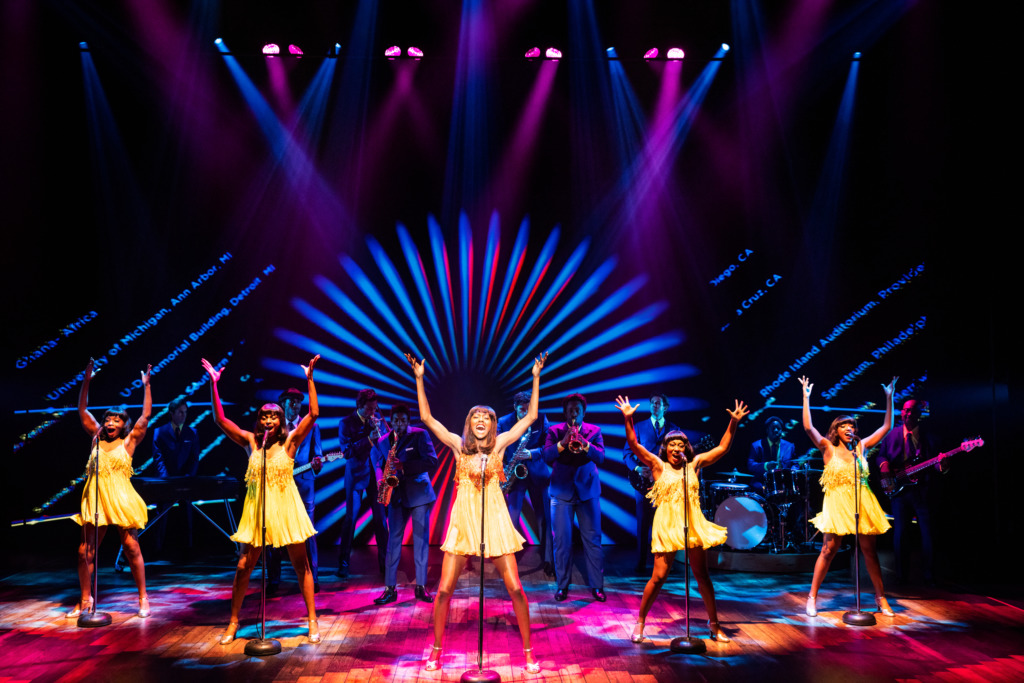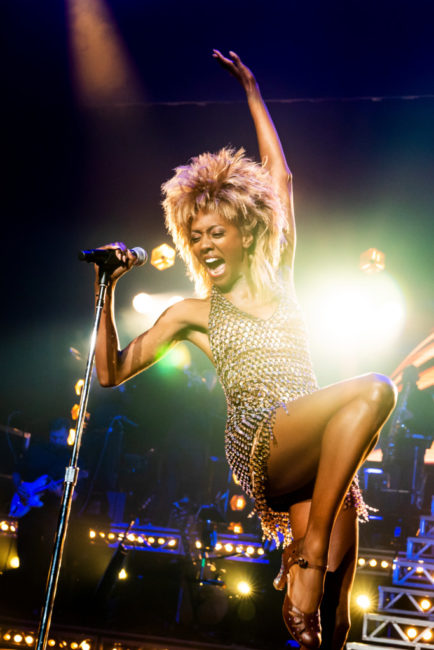Tina Turner is arguably the most inspirational story in the history of rock and roll. Small town country girl with a big voice becomes part of a rock and roll institution. But success seemed stacked against her between an emotionally abusive mother and the most physically abusive husband this side of OJ Simpson, as she flees everything at the height of her career to start over with nothing, making perhaps the grandest comeback in rock and roll history. This story is famously told in the 1993 musical biopic What’s Love Got to Do with It? based on her autobiography I, Tina, starring Angela Bassett and Lawrence Fishburne giving memorable performances as Ike and Tina Turner. That movie jolted the world who never knew the “Behind the Music” story of violence and fear Tina suffered at the hands of her possessive and jealous husband. But this ultimate musical story of determination and redemption in the hands of new, dynamic performers telling it under the direction of Phyllida Lloyd (no stranger to the jukebox musical format, having developed it and struck Broadway gold with the quintessential entry in the genre, Mamma Mia) makes for an enjoyable tale of rise, fall, and redemption on its own terms.

The title role is so physically and vocally demanding that it takes two actors, Naomi Rodgers and Zurin Villanueva (Villanueva at this performance), to cover 8 draining shows a week. And Villanueva has all the well-known vocal inflections, postures, gestures, and dance moves down to convincingly give the Queen of Rock and Roll her due. Not merely giving an impersonation of Turner, Villanueva gives her full emotional range and performance energy to bring the larger than life legend to fruition. Excelling in recreating classic performances like the iconic choreography of “Proud Mary”, she is also effective in smaller moments as bumpkin Anna Mae Bullock discovering her confidence and fame after moving to St. Louis to be with her cold, distant mother Zelma (Roz White) and falling under the spell of beguiling rising star Ike Turner (Garrett Turner). Villanueva has all the requisite flash and star quality to realize Turner as concert superstar tearing up hit after hit, but she is at her best in moments like the quiet first act finale recreating the infamous event where Turner, with 36 cents to her name, escapes Ike and begs a chain motel to give her a room solely on her word and notoriety to the tune of “I Don’t Wanna Fight No More”.
The rest of the cast under director Lloyd’s guidance is solid support. Roz White is a standout as her sarcastic, self-centered mother Zelma Bullock, who escaped her own abusive marriage in Nutbush and transported older daughter Alline (Parris Lewis) to St. Louis while leaving young Anna Mae (an endearing Ayvah Johnson) at home with her grandmother (a gentle and nurturing Ann Nesby). White’s razor-sharp dark comedic delivery masks the regret and frustration of a reluctant mother, and her ability to sleep with the devil is chilling as she maintains a relationship with Ike behind her daughter’s back for her own selfish gain.
In the totally thankless role of wife beating Ike Turner, Garrett Turner commits to the fact he will play the most unlikable character in modern musical theatre. Katori Hall’s book (with Frank Ketelaar and Kees Prins) is totally black and white on Ike, with no shades of the charismatic charmer who lures young Anna Mae in or creates the persona of Tina Turner. Within three scenes he’s reduced to a violent womanizing cocaine addict who wrecks terror on Tina and her bandmates scene after scene. To Turner’s credit, he doesn’t shy away from the unsympathetic and excessively violent portrayal and embodies Ike Turner as the monster he was.

Set and costume designer Mark Thompson does an adequate job of creating the classic looks of Tina across the eras—lots of fringe and beaded shimmy dresses for the Ike & Tina days, leather minidresses for her 80’s comeback—and suggested sets that mark time between his more formidable concert sets. He gets a great assist from projection designer Jeff Sugg who provides realistic background art to flesh out his more minimalist designs as well as modern day stadium mock pyrotechnics to dazzling effect. Lighting designer Bruno Poet provides an array of internal and late-night external lighting, but again excels in his concert and performance plots.
The behind-the-scenes star who contributes the most to the look and the feel of the subject over the years is choreographer Anthony Van Laast who recreates all the iconic moves the audience expects from Tina and the Ikettes in “Proud Mary” to all the strut and pose leggy moves from her 80’s videos. When Tina is in concert, the show takes off and it’s due to Van Laast’s enthralling dance moves as much as it is to Villanueva’s powerhouse performance.
The weakest element if the production is Hall’s incredibly uneven book. Even without unfair comparisons to the well-known movie’s superior screenplay, the pacing is off. The first act is long and action-packed with high-energy musical numbers from the Ike & Tina years and the compelling drama of their turbulent marriage. She does not shy away from Ike’s abuse and at times it is graphic and disturbing to watch, as it should be. But in packing so much into one act, she never really shows us what was so charming about Ike to begin with that Tina (and her greedy mother) were so taken with him. And important plot points are glossed over in throwaway dialogue, including Tina’s desperate attempt to get out from under Ike’s thumb so badly that she walked away with no divorce settlement, no rights to her music with him, and no equity in their property (all she famously asked for was her stage name to continue performing under).
There is also the inherent pitfall of jukebox musicals where some songs feel forked into the story just because they’re expected. It’s especially obvious here because Turner’s catalog is so disparate between her Ike & Tina classics and her pioneering 80’s sounds. Squeezing her theme from Thunderdome in as a funeral dirge, or “Nutbush City Limits” as a backwoods church hymn have dubious results. Yet at other times, when it shouldn’t work, the talented cast sells it, like Nesby singing “Don’t Turn Around” to Anna Mae as she encourages her to leave their small town and make her future or when love interest bandmate Raymond (Taylor A. Blackman) whose smooth sounds on “Let’s Stay Together” bring the house down as he persuades Tina to run off with him before the controlling Ike finds out and destroys them both.
The second act, however, dealing with Tina’s reinvention and 80’s comeback, is a long 60 minutes of hip European record executives trying to persuade her to record “What’s Love Got to Do with It?” (We get it. She resists, as a woman finding her strength refusing to let men make all her career decisions any longer. For the entire act.) But all is forgiven in the finale/curtain call brilliance of Tina’s best, showcasing the legend with a medley of “Simply the Best”, “What’s Love Got to Do with It”, and a fireworks finale of “Proud Mary” which sends the audience out with a bang.
Ultimately a show that succeeds more on its beloved subject matter and strong, dynamic performances than its execution, Tina: The Tina Turner Musical is a worthy salute to a legendary woman. Shake a tailfeather and get your tickets for an enjoyable glimpse of rock and roll history.
Running Time: 2 hours and 30 minutes with one intermission
Tina: The Tina Turner Musical plays through November 20, 2022, at Baltimore’s Hippodrome Theatre as a part of the Broadway Across America touring series in the France-Merrick Performing Arts Center— 12 N. Eutaw Street in the Bromo Seltzer Arts District of Baltimore, MD. For tickets call the box office at (410) 752-7444 or purchase them purchase them online.
